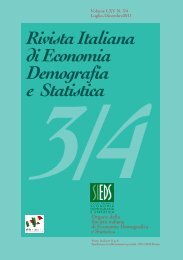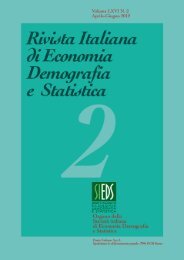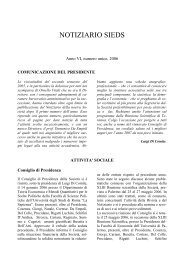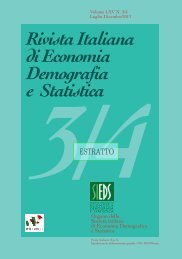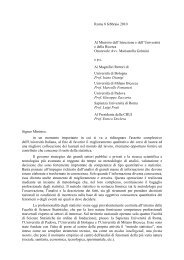rivista italiana di economia demografia e statistica - Sieds
rivista italiana di economia demografia e statistica - Sieds
rivista italiana di economia demografia e statistica - Sieds
You also want an ePaper? Increase the reach of your titles
YUMPU automatically turns print PDFs into web optimized ePapers that Google loves.
Rivista Italiana <strong>di</strong> Economia Demografia e Statistica Volume LXV n. 1 – Gennaio-Marzo 2011<br />
1. Introduction<br />
ALTERNATIVE VARIANTS OF THE<br />
HELIGMAN-POLLARD MODEL<br />
Anna Maria Altavilla, Angelo Mazza, Antonio Punzo<br />
In demographic analysis and actuarial practice, the use of crude age-specific<br />
mortality rates is often deemed as not appropriate since the observed-data<br />
pattern may be intended as a single realization of a stochastic process.<br />
To cope with this issue, several graduation techniques have been proposed in<br />
literature, based on the assumption that if the number of in<strong>di</strong>viduals in the group on<br />
whose experience data are based were considerably larger, then the set of observed<br />
in<strong>di</strong>cators would <strong>di</strong>splay a much more regular progression with age (Copas and<br />
Haberman, 1983).<br />
In detail, the relation between the crude rates and the true but unknown<br />
mortality rates may be summarized as<br />
where denotes noise due to random variation, age misstatement, etc.. Such<br />
random fluctuations are usually more evident when small area datasets are<br />
investigated or at ages in which mortality is itself rarer.<br />
In order to capture the underlying mortality pattern from the crude rates, a<br />
graduation function<br />
)<br />
is used; ) aims at smoothing out irregularities in crude mortality rates .<br />
In analogy with the usual <strong>statistica</strong>l modelling, the ) function can be<br />
specified parametrically (see, e.g. Debòn et al., 2005) or nonparametrically (see,<br />
e.g. Debòn et al., 2006). In the following, we will address a specific class of<br />
parametric models often employed by demographers, in which the function<br />
described as<br />
is<br />
,<br />
, (1)



